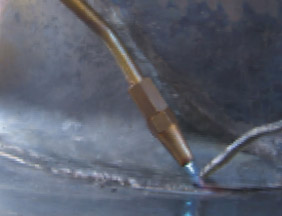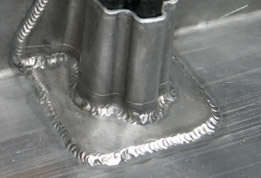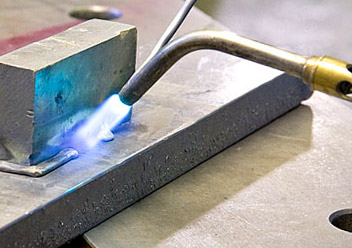Summary
The welding of lead is similar to welding of other metals except that no flux is required.
Processes other than gas welding are not in general use.
Lead can be identified by the color of an unfinished surface (white to gray), the color and structure of a newly fractured surface (light gray, crystalline), the color of a freshly filed surface (white).

Gases Used
Three combinations of gases are commonly used for lead welding:
- Oxyacetylene
- Oxyhydrogen
- Oxygen-natural gas
The oxyacetylene and oxyhydrogen processes are satisfactory for all positions.
The oxygen-natural gas is not used for overhead welding.
A low gas pressure ranging from 1-1/2 to 5 psi (10.3 to 34.5 kPa) is generally used, depending on the type of weld to be made.

Lead Welding Torch
The welding torch is relatively small in size.
The oxygen and flammable gas valves are located at the forward end of the handle so that they may be conveniently adjusted by the thumb of the holding hand.
Torch tips range in drill size from 78 to 68.
The small tips are for 6.0 lb (2.7 kg) lead (i.e., 6.0 lb per sq ft), the larger tips for heavier lead.

Welding Rods
The filler rods should be of the same composition as the lead to be welded.
They range in size from 1/8 to 3/4 in. (3.2 to 19.1 mm) in diameter.
The smaller sizes are used for lightweight lead and the larger sizes for heavier lead.
Types of Joints
Butt, lap, and edge joints are the types most commonly used in this type of welding.
Either the butt or lap joint is used on flat position welding.
The lap joint is used on vertical and overhead position welding.
The edge or flange joint is used only under special conditions.
Application
- The flame must be neutral.
- A reducing flame will leave soot on the joint.
- An oxidizing flame will produce oxides on the molten lead and impair fusion.
- A soft, bushy flame is most desirable for welding in a horizontal position.
- A more pointed flame is generally used in the vertical and overhead positions.
The flow of molten lead is controlled by the flame, which is usually handled with a semicircular or V-shaped motion. This accounts for the herringbone appearance of the lead weld.
The direction of the weld depends on the type of joint and the position of the weld.
- Vertical position: Lap joints are started at the bottom of the joint. A welding rod is not generally used.
- Flat position: Lap joints are preferred. The torch is moved in a semicircular path toward the lap and then away. Filler metal is used but not on the first pass.
- Overhead position: Welding is very difficult – for that position, a lap joint and a sharp flame are used. The molten beads must be small and the welding operation must be completed quickly.